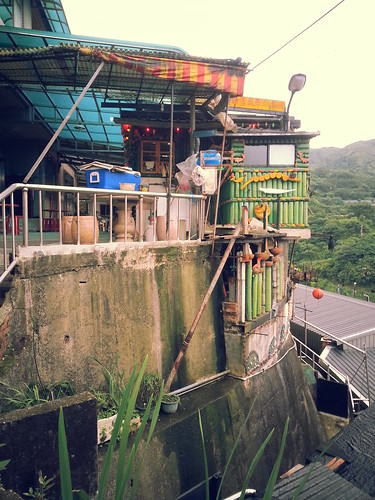I've been reading up on Taiwan in 1895, just to get a feel for what was going on at the time China dumped the island on Japan as part of the Treaty of Shimoneseki. Just doing the math, it's now 118 years since China got rid of us. Anyway, I came across this report on the climate, which I found interesting. It was written by N. Perkins, an assistant to the British Consul in Tamsui. I've never seen anything else by him, which is a pity as he writes well. He also types, which makes things a lot easier. Most of the consular reports are in cursive, so they can be quite the slog:
The Formosan seas are well known for their typhoons, chiefly occurring between June and October.
The velocity and violence of the winds during the height of these storms is almost incredible, and from their rotatory course they test to the utmost skill of the builder, whether of house or ship.
The rain is swept in steam-like masses along the ground, and the rivers appear to be lifted bodily from their beds.
These tremendous storms cause the want of harbours along the coast to be more severely felt. Tainan, however, seldom feels the force of typhoons, which usually break off east or west at South Cape.
Earthquakes are also of frequent occurrence, and it is always considered an ominous sign when a long period of time elapses without some shock being felt. There is a record of a severe shock in 1782, which is said to have effected [I checked the dictionary and this seems to be correct] a considerable change in the outline of the coast. A frightful convulsion occurred in 1862, and more recently violent shocks of 1881, 1882, and 1892.
From what has been said above it will be seen that the island tends, however slowly, to reunite itself with the mainland, from which its severance at remote period was probably due to some volcanic convulsion.
Much has been written about Taiwan's ship-wreckers (bandits who looted and stripped ships in need of repair after storms and thus stranded off Taiwan). Their business was a lucrative one in the past due to the conditions Perkins describes: the violent storms and lack of good harbors for ships to escape from them. We shouldn't forget that Taiwan was a fairly lawless frontier prior to the arrival of the Japanese. I imagine the situation off Taiwan's shores resembled what is going on right now near Somalia. In addition to the law and order provided by Japan starting in 1895, it should be noted that technology and a better understanding of weather patterns also worked to put these groups out of business. I checked the records for the previous year and there were only two wrecks, a Norwegian schooner called the Sylphiden and an American barque called the Mary L. Stone. The Sylphiden, stranded just south of Tamsui, was towed into Tamsui's harbor. She was then dismantled and sold, I am guessing, by the owners. The Mary L. Stone washed ashore at Ilan. The cargo, kerosene bound for Shanghai, was a "total loss." Luckily, nobody died.
The part about the earthquakes reminds me of the 1999 "9/21" earthquake, when a 7.3 quake hit the island in the middle of the night. After that, Jade Mountain, Taiwan's highest peak, was said to have shrunk by several meters. There is a pretty good account of it on wiki. The wiki write-up for the 1935 Hsinchu-Taichung earthquake, Taiwan's deadliest earthquake on record, is solid as well. I want to mention the earthquake of 1654. WM Campbell covers it and others in Formosa Under the Dutch (page 7):
On 14 December 1654, there happened a mighty one which with short intermissions, continued for seven weeks. Indeed, some have been so unusually violent that the valleys, mountains, and houses moved like a ship on the waves, as if the whole of the land were about to sink altogether.
I know I am wandering now, but I'm going to close out by saying the 1650s weren't a good time for Taiwan when it came to Mother Nature. Writes Campbell:
During 1655, [an] abundance of locusts spread themselves over the islands of Formosa and Tayouan [where the Dutch fort Zeelandia was located]. Their first appearance was in Tayouan, where they fell down from the sky like a great fall of snow, and covered all the ground. After two or three days they directed their way to Sakam [modern Yanshui 鹽水, I think] . . . and multiplied in such numbers that no place was free of them. The people of Sakam tried to destroy them, and in four or five days the bodies of those they collected weighed thirty thousand piculs [or shoulder loads]; but it proved in vain and efforts were given up, for the locust[s] continued to increase until all the sugar-cane and rice crops were utterly destroyed.
















